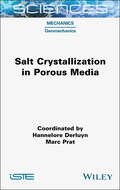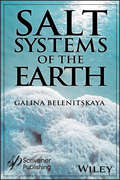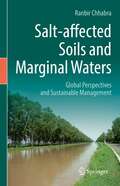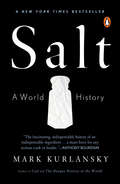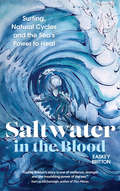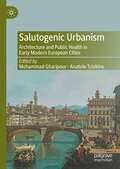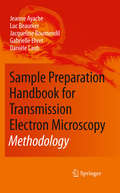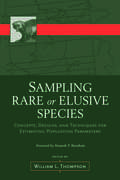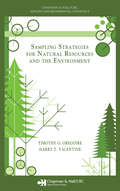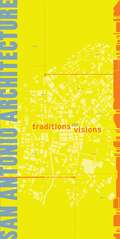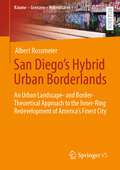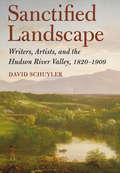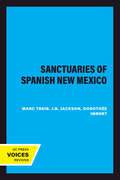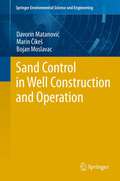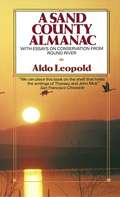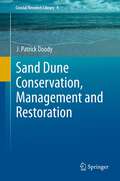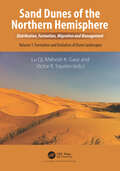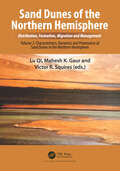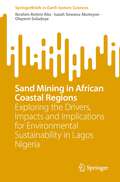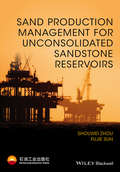- Table View
- List View
Salt Crystallization in Porous Media (ISTE Consignment)
by Marc Prat Hannelore DerluynThe crystallization of one or multiple salts in porous media (rocks, soils, building materials, etc.) is a subject of major interest in connection with numerous issues such as soil salinization, evaporation, CO2 injection into saline aquifers, the durability of building materials and the preservation of our cultural heritage. Salt Crystallization in Porous Media provides an interdisciplinary review of the key scientific knowledge required to understand this field of research, and illustrates the issues involved through a series of concrete examples. This book has been written for students completing their Master’s level degree or higher in the field, as well as researchers and engineers interested in this research. It may also be of interest to a wider readership, as certain sections can be used to illustrate basic concepts, reaching beyond the subject of salt crystallization itself.
Salt Systems of the Earth: Distribution, Tectonic and Kinematic History, Salt-Naphthids Interrelations, Discharge Foci, Recycling
by Galina BelenitskayaLike water, salt is one of the most commonplace items in our everyday lives. From the omnipresent shaker that you see on every table in every restaurant, to the ocean water we swim in, salt is something that we rarely think about. But there is much more to the story of salt than most people think. Not only is salt a natural resource that must be captured and refined for public consumption, but “salt domes,” large deposits of salt that form under the ground, are important for finding and drilling for petroleum and natural gas. Salt is so important that, in ancient times, it was sometimes used as a currency in various cultures around the world, and it has been used as a food preservative, long before refrigeration was invented. Salt is something we rarely think about, but it is one of the most important natural resources that exists. This is the first integrated study of salt’s global development in the Earth’s subsurface, its tectonic history and kinematic evolution, “live” salt-naphtide interconnections, and their geological recycling. The Earth’s salt is shown as a peculiar umbilical thread in the analysis of numerous geological processes of salt formation, transformation, migration, discharge and regeneration, and their association with hydrocarbons. Presented here is the science of salt, including the active salt bodies’ “live” in Earth’s subsurface, their fate and influence over the other geological processes, including grandiose systems of kinetically interrelated allochthonous nappe-like and sub-vertical bodies formed by the migrating salt. Also included are a description of sub-conformable sheet-like salt bodies formed not by the evaporation but by emigration of buried brine-salt masses and their discharge at new, younger stratigraphic levels, a description of a phenomenon of the “halo-volcanism” due to depth breakthroughs and explosive discharges of the hydrocarbon-brine-salt masses, an examination of the over-diapir surface and brine lakes with fluctuating levels, and many other things. The book provides new interpretations of numerous issues reflecting the salt “life” manifestations and gives a key to a broad circle of the geological enigmas, from global events like the Messinian crisis in the Mediterranean to Biblical legends and enigmas of the Dead Sea-lake. Whether you are a scientist or student working in the natural or Earth sciences, a geologist, an anthropologist, a petroleum engineer, a petrophysicist, or any other engineer or student working in petroleum engineering, this groundbreaking work is a must-have. Perfect for any scientist or engineer’s library, this volume can be a must-read page-turner or a valuable reference work.
Salt-affected Soils and Marginal Waters: Global Perspectives and Sustainable Management
by Ranbir ChhabraThis book presents systematic scientific appraisal, classification, genesis and viable technologies for reclamation and management of salt-affected soils and marginal quality waters across India and several other countries. Nature, solubility and geo-chemical mobility of salts have been provided as basis for the development of alkali and saline soils and groundwaters under specific agro-hydro-ecological regions. Chemical amendment (gypsum) based reclamation technology of alkali soils and related pre and post-reclamation water, nutrient and crop management interventions, including re-sodification issues have been comprehensively addressed. Features and operational guidelines of surface, subsurface, vertical and bio-drainage systems have been thoroughly discussed; likewise, amelioration of irrigation induced saline soils in inland and coastal regions and preventive measures for control of salinity and waterlogging along with environmental trade-offs. Practical approaches for amelioration and judicious use of saline, alkali, high SAR- saline and waste waters have been synthesized for different cropping and agro- forestry systems. Emerging issues on use of industrial by-products as amendments for alkali soils, physiological aspects of salt resistance, anatomical and biochemical mechanism of submergence tolerance, specific ion effects of poor quality waters, crop diversification, groundwater recharge, rejuvenation of tsunami affected coastal soils, safety against occurrence of poisonous gas in tube well pits, paddy straw burning and others have been adequately deliberated upon. Combining scientific principles with field experiences, the book is expected to serve as a useful knowledge base for research workers, teachers and students of soil science, agronomy, plant breeding, forestry, irrigation engineering, extension workers, environmentalists and planners associated with reclamation and management of salt affected soils and waters on sustainable basis in developing and developed countries.
Salt: A World History (Core Ser.)
by Mark KurlanskyAn unlikely world history from the bestselling author of Cod and The Basque History of the WorldIn his fifth work of nonfiction, Mark Kurlansky turns his attention to a common household item with a long and intriguing history: salt. The only rock we eat, salt has shaped civilization from the very beginning, and its story is a glittering, often surprising part of the history of humankind. A substance so valuable it served as currency, salt has influenced the establishment of trade routes and cities, provoked and financed wars, secured empires, and inspired revolutions. Populated by colorful characters and filled with an unending series of fascinating details, Salt is a supremely entertaining, multi-layered masterpiece.From the Trade Paperback edition.
Saltwater in the Blood: Surfing, Natural Cycles and the Sea's Power to Heal
by Easkey BrittonPowerful feminist nature writing by the pioneer of women's big-wave surfing in Ireland. Easkey Britton provides a rare female perspective on surfing, exploring the mental skills it fosters, and the need to recognize the value of the ocean and of nature's cycles in our lives.This is an incredibly inspiring exploration of the sea's role in the wellness of people and the planet, beautifully written by Easkey Britton – surfer, scientist and social activist. She offers a powerful female perspective on the sea and surfing, explaining what it&’s like to be a woman in a man's world and how she promoted the sport to women in Iran, surfing while wearing a hijab. She speaks of the undiscussed taboo around entering the water while menstruating – and of how she has come to celebrate her own bodily cycles. She has developed her own approach to surfing, which instead of seeking to dominate the waves, works in tune with the natural cycles of her body, the moon and the seasons. In a society that rewards busyness, she believes that understanding the influence of cycles becomes even more important – and we all have them, men and women. For Easkey, the sea is a source of mental and physical wellbeing. She explores the mental toughness needed in big-wave surfing, and presents surfing as an embodied mindfulness practice in which we can find flow and connect with the movement of the waves. She stresses the need to recognize the ocean as our most powerful ally when addressing our greatest global challenge: the climate crisis. Above all, Easkey&’s relationship to the sea has taught her about the need to meet life and evolve with it, rather than seeking to control it. By such wisdom our planet might just survive and thrive.
Salutogenic Urbanism: Architecture and Public Health in Early Modern European Cities
by Mohammad Gharipour Anatole TchikineThis book offers a new, salutogenic, perspective on the development of early modern cities by exploring profound and complex ways in which architecture and landscape design served to promote public health on an urban scale. Focusing on fifteenth- through nineteenth-century Europe, it addresses the histories of spaces and institutions that supported salubrious living, highlighting the intersections of medical theory, government policy, and architectural practice in designing, improving, and monumentalizing the infrastructure of sanitation and healthcare. Studies in this book highlight the joint role of design thinking and scientific practice in reforming the facilities for treating and preventing disease; the impact of cross-cultural exchange on early modern strategies of urban improvement; and the creation of new therapeutic environments through state, communal, and private initiatives concerned with the preservation of physical and mental health, from recreational landscapes to spa resorts.
Samkalin Bharat Bhag-1 class 9 - JCERT: समकालीन भारत भाग-१ ९वीं कक्षा - जेसीईआरटी
by Jharkhand Shaikshik Anusandhan Evam Prashikshan Parishad Ranchi"समकालीन भारत - 1" कक्षा 9 की सामाजिक विज्ञान की पाठ्यपुस्तक है, जो छात्रों को भारत के भूगोल, जलवायु, वनस्पति, जनसंख्या आदि विषयों की जानकारी प्रदान करती है। यह पुस्तक छात्रों को भारत की भौगोलिक विविधताओं, जनसंख्या वृद्धि, जलवायु परिवर्तन, और संसाधनों के बारे में विस्तृत रूप से समझाती है। इसमें भारत के भौतिक स्वरूप को विभिन्न भौगोलिक विभाजनों में बाँटा गया है, जैसे कि हिमालय पर्वत, उत्तरी मैदान, प्रायद्वीपीय पठार, तटीय मैदान और द्वीप समूह। साथ ही, भारत की प्रमुख नदियों और उनके अपवाह तंत्रों पर भी विस्तार से चर्चा की गई है। पुस्तक में जलवायु और प्राकृतिक वनस्पति के विभिन्न प्रकारों की चर्चा की गई है, जो छात्रों को पर्यावरण और उसकी संरचना के प्रति जागरूक करती है। इस पाठ्यपुस्तक में दी गई जानकारी छात्रों को भारत के समग्र भूगोल और उसके विभिन्न पहलुओं को समझने में मदद करती है। पुस्तक के अंत में अभ्यास और परियोजना कार्य दिए गए हैं, जो छात्रों को विषय की गहरी समझ विकसित करने में सहायक हैं।
Samkalin Bharat Bhag-2 class 10 - Himachal Pradesh Board: समकालीन भारत भाग-२ कक्षा १० - हिमाचल प्रदेश बोर्ड
by Himachal Pradesh Board of School Education - Dharamshalaहिमाचल प्रदेश स्कूल शिक्षा बोर्ड, धर्मशाला द्वारा प्रकाशित कक्षा 10 के लिए " समकालीन भारत भाग-२" का डिजिटल संस्करण, 2017 से 2022 तक की विभिन्न संस्करणों और पुनर्मुद्रितियों को शामिल करता है। इसका सारांश पाठ्यक्रम और शिक्षण प्रक्रिया के माध्यम से शिक्षकों और छात्रों के बीच एक सेतु के रूप में काम करता है। यह मूल्यांकन, संबोधन, और अच्छी तरह से प्रस्तुत सामग्री की महत्वता पर जोर देता है। शिक्षा में सुधार की आवश्यकता पर ध्यान देते हुए राष्ट्रीय पाठ्यचर्चा रूपरेखा 2005 और परीक्षा सुधारों पर राष्ट्रीय फोकस समूह के स्थिति पत्र ने परीक्षाओं में पूछे जाने वाले प्रश्नों के तरीकों में बदलाव के लिए अपील की है। इस पुस्तक में कुल सात अध्याय है। संसाधन एवं विकास, वन एवं वन्य जीव संसाधन, जल संसाधन, कृषि, खनिज तथा ऊर्जा संसाधन, विनिर्माण उद्योग, राष्ट्रीय अर्थव्यवस्था की जीवन रेखाएँ आदी के बारे जानकारी दी गई है। राष्ट्रीय स्तर पर पाठ्यपुस्तकों के निर्माण का दायित्व एन. सी. ई. आर. टी. को दिया गया है ताकि शिक्षा के राष्ट्रीय स्तर पर समरूपता बनी रहे। हिमाचल प्रदेश शिक्षा बोर्ड, एन.सी.ई.आर.टी. का आभारी हैं क्योंकि उन्होंने हमें उनके द्वारा परिश्रमपूर्वक तैयार की गई पुस्तकों को पुनर्मुदित कर अपने छात्रों तक पहुंचाने का अधिकार दिया है। छात्रें में भू-स्थानिक कौशल विकसित करने के उद्देश्य से एनसीईआरटी तथा इसरो ने मिलकर ऑनलाइन वेब आधारित भू-स्थानिक पोर्टल स्कूल-भुवन-एनसीईआरटी बनाया है। इस भू-स्थानिक पोर्टल पर भूगोल की पाठ्यपुस्तकों में दिए गए मानचित्र उपलब्ध हैं। यह पोर्टल छात्रें में भू-स्थानिक तकनीक के उपयोग द्वारा भूगोल की विभिन्न संकल्पनाओं को समझने में मदद करता है।
Samkalin Bharat Bhag-2 class 10 - JCERT: समकालीन भारत भाग-२ १०वीं कक्षा - जेसीईआरटी
by Jharkhand Shaikshik Anusandhan Evam Prashikshan Parishad Ranchiसमकालीन भारत - 2 कक्षा 10 की भूगोल पाठ्यपुस्तक है, जो भारत के विभिन्न भौगोलिक, पर्यावरणीय और आर्थिक पहलुओं पर केंद्रित है। पुस्तक में कुल सात अध्याय हैं, जो संसाधनों, वन्य जीवन, जल संसाधनों, कृषि, खनिज और ऊर्जा संसाधनों, विनिर्माण उद्योगों और परिवहन जैसे महत्वपूर्ण विषयों को कवर करते हैं। पहला अध्याय संसाधन एवं विकास में संसाधनों के प्रकार और उनके सतत उपयोग की चर्चा है, जिसमें संसाधन नियोजन की आवश्यकता पर जोर दिया गया है। दूसरा अध्याय वन और वन्य जीव संसाधन भारत की जैव विविधता, लुप्तप्राय प्रजातियों और संरक्षण की आवश्यकता को रेखांकित करता है। जल संसाधन पर तीसरा अध्याय जल की कमी, जल संरक्षण और प्रबंधन के उपायों की आवश्यकता पर केंद्रित है। चौथे अध्याय कृषि में कृषि के प्रकार, फसलों की विविधता और राष्ट्रीय अर्थव्यवस्था में कृषि के योगदान की चर्चा की गई है। पांचवा अध्याय खनिज और ऊर्जा संसाधन विभिन्न प्रकार के खनिज और ऊर्जा संसाधनों, उनके वितरण और संरक्षण की आवश्यकता को समझाता है। विनिर्माण उद्योग पर छठा अध्याय उद्योगों के राष्ट्रीय अर्थव्यवस्था में महत्व और पर्यावरणीय समस्याओं का वर्णन करता है। अंत में, राष्ट्रीय अर्थव्यवस्था की जीवन रेखाएँ नामक सातवां अध्याय परिवहन और संचार सेवाओं की महत्ता, और उनके देश की अर्थव्यवस्था में योगदान को स्पष्ट करता है। यह पुस्तक छात्रों को भारत के समकालीन मुद्दों और संसाधनों के विवेकपूर्ण उपयोग के महत्व को समझाने का प्रयास करती है।
Sample Preparation Handbook for Transmission Electron Microscopy: Methodology
by Jeanne Ayache Danièle Laub Jacqueline Boumendil Gabrielle Ehret Luc BeaunierThis two-volume Handbook is a comprehensive and authoritative guide to sample preparation for the transmission electron microscope. This first volume covers general theoretical and practical aspects of the methodologies used for TEM analysis and observation of any sample. The information will help you to choose the best preparative technique for your application taking into account material types, structures, and their properties. Physical properties, material classification, and microstructures are considered together with a thorough description of the physics and chemistry of sample preparation and the main artifacts brought about by mechanical, physical and chemical methods, principles which are also applicable to sample preparation for the SEM, AFM etc.. Also included is a discussion of how to combine techniques for complex sample analysis and to obtain a TEM thin slice. Sample Preparation Handbook for Transmission Electron Microscopy: Methodology will guide you through the most current techniques for successful sample preparation in all fields from materials science to biology. The remainder of the book is dedicated to technical hints, including 22 detailed protocols for preparing thin slices for TEM analysis. Experimental conditions and guidelines, options and variations, advantages and constraints, common artefacts, and theoretical issues are considered. Particular attention is given to the type of material, conditioning, compatible analysis of a given preparation, and risks. Finally, a practical, authoritative, and interdisciplinary handbook is available to guide you through all of the most current techniques for successful sample preparation in all fields from materials science to biology.
Sampling Rare or Elusive Species: Concepts, Designs, and Techniques for Estimating Population Parameters
by William ThompsonInformation regarding population status and abundance of rare species plays a key role in resource management decisions. Ideally, data should be collected using statistically sound sampling methods, but by their very nature, rare or elusive species pose a difficult sampling challenge. Sampling Rare or Elusive Species describes the latest sampling designs and survey methods for reliably estimating occupancy, abundance, and other population parameters of rare, elusive, or otherwise hard-to-detect plants and animals. It offers a mixture of theory and application, with actual examples from terrestrial, aquatic, and marine habitats around the world. Sampling Rare or Elusive Species is the first volume devoted entirely to this topic and provides natural resource professionals with a suite of innovative approaches to gathering population status and trend data. It represents an invaluable reference for natural resource professionals around the world, including fish and wildlife biologists, ecologists, biometricians, natural resource managers, and all others whose work or research involves rare or elusive species.
Sampling Strategies for Natural Resources and the Environment (Chapman & Hall/CRC Applied Environmental Statistics)
by Timothy G. Gregoire Harry T. ValentineWritten by renowned experts in the field, Sampling Strategies for Natural Resources and the Environment covers the sampling techniques used in ecology, forestry, environmental science, and natural resources. The book presents methods to estimate aggregate characteristics on a per unit area basis as well as on an elemental basis. In addition to comm
San Antonio Architecture
by San Antonio Boone PowellWith a history more than 290 years old, San Antonio boasts a diverse, eclectic, and important architectural inventory. From the Spanish Missions of the 17th century to invigorating adaptation and restoration of historic buildings alongside landmark new construction, there is a wide array of culturally significant assets reflecting Anglo and Hispanic traditions, alongside regional variations of southern and southwestern American styles.San Antonio Architecture is the comprehensive catalog of the architecture inventory of the city. Complete with color illustrations, keyed maps, and informative essays, it is a must-have book for every armchair and on foot architectural, art, and community historian.
San Antonio Architecture
by San Antonio Boone PowellWith a history more than 290 years old, San Antonio boasts a diverse, eclectic, and important architectural inventory. From the Spanish Missions of the 17th century to invigorating adaptation and restoration of historic buildings alongside landmark new construction, there is a wide array of culturally significant assets reflecting Anglo and Hispanic traditions, alongside regional variations of southern and southwestern American styles.San Antonio Architecture is the comprehensive catalog of the architecture inventory of the city. Complete with color illustrations, keyed maps, and informative essays, it is a must-have book for every armchair and on foot architectural, art, and community historian.
San Antonio Architecture
by San Antonio Boone PowellWith a history more than 290 years old, San Antonio boasts a diverse, eclectic, and important architectural inventory. From the Spanish Missions of the 17th century to invigorating adaptation and restoration of historic buildings alongside landmark new construction, there is a wide array of culturally significant assets reflecting Anglo and Hispanic traditions, alongside regional variations of southern and southwestern American styles.San Antonio Architecture is the comprehensive catalog of the architecture inventory of the city. Complete with color illustrations, keyed maps, and informative essays, it is a must-have book for every armchair and on foot architectural, art, and community historian.
San Diego's Hybrid Urban Borderlands: An Urban Landscape- and Border-Theoretical Approach to the Inner-Ring Redevelopment of America’s Finest City (Räume – Grenzen – Hybriditäten)
by Albert RossmeierThis study aims for a wider understanding of the redevelopment processes that emerged several decades ago in downtown San Diego and now gradually spread over the downtown edges into the inner ring. Perspectively situated in the fields of urban landscape and urban border studies, the research project outlines how the eastward ‘redevelopment wave’ in San Diego contests socialized neighborhood (boundary) perceptions by transforming the former first-tier suburbs from disinvested communities into ‘urban villages’ and trendy places to be. The study shows how the redevelopment perforates, dissolves, and shifts socialized, linear neighborhood boundaries into areas that are simultaneously part of the one and the other neighborhood. In the present work, the resulting, rather undefined or stretched border areas have been referred to as hybrid urban borderlands. This notion is a novel conceptual approach that can be deemed a promising lens for future studies on neighborhood change, urban redevelopment, and socio-spatial re-interpretation beyond the context of San Diego.
Sanctified Landscape: Writers, Artists, and the Hudson River Valley, 1820–1909
by David SchuylerThe Hudson River Valley was the first iconic American landscape. Beginning as early as the 1820s, artists and writers found new ways of thinking about the human relationship with the natural world along the Hudson. Here, amid the most dramatic river and mountain scenery in the eastern United States, Washington Irving and James Fenimore Cooper created a distinctly American literature, grounded in folklore and history, that contributed to the emergence of a sense of place in the valley. Painters, led by Thomas Cole, founded the Hudson River School, widely recognized as the first truly national style of art. As the century advanced and as landscape and history became increasingly intertwined in the national consciousness, an aesthetic identity took shape in the region through literature, art, memory, and folklore-even gardens and domestic architecture. In Sanctified Landscape, David Schuyler recounts this story of America's idealization of the Hudson Valley during the nineteenth and early twentieth centuries. Schuyler's story unfolds during a time of great change in American history. At the very moment when artists and writers were exploring the aesthetic potential of the Hudson Valley, the transportation revolution and the rise of industrial capitalism were transforming the region. The first generation of American tourists traveled from New York City to Cozzens Hotel and the Catskill Mountain House in search of the picturesque. Those who could afford to live some distance from jobs in the city built suburban homes or country estates. Given these momentous changes, it is not surprising that historic preservation emerged in the Hudson Valley-the first building in the United States preserved for its historic significance is Washington's Headquarters in Newburgh. Schuyler also finds the seeds of the modern environmental movement in the transformation of the Hudson Valley landscape. Richly illustrated and compellingly written, Sanctified Landscape makes for rewarding reading. Schuyler expertly ties local history to national developments, revealing the Hudson River Valley was so important to nineteenth-century Americans-and why it is still beloved today.
Sanctuaries of Spanish New Mexico
by Marc TreibThis title is part of UC Press's Voices Revived program, which commemorates University of California Press’s mission to seek out and cultivate the brightest minds and give them voice, reach, and impact. Drawing on a backlist dating to 1893, Voices Revived makes high-quality, peer-reviewed scholarship accessible once again using print-on-demand technology. This title was originally published in 1993.This title is part of UC Press's Voices Revived program, which commemorates University of California Press’s mission to seek out and cultivate the brightest minds and give them voice, reach, and impact. Drawing on a backlist dating to 1893, Voices Revived</DIV
Sand Control in Well Construction and Operation
by Bojan Moslavac Davorin Matanovic Marin CikesProduced sand causes a lot of problems. From that reasons sand production must be monitored and kept within acceptable limits. Sand control problems in wells result from improper completion techniques or changes in reservoir properties. The idea is to provide support to the formation to prevent movement under stresses resulting from fluid flow from reservoir to well bore. That means that sand control often result with reduced well production. Control of sand production is achieved by: reducing drag forces (the cheapest and most effective method), mechanical sand bridging (screens, gravel packs) and increasing of formation strength (chemical consolidation). For open hole completions or with un-cemented slotted liners/screens sand failure will occur and must be predicted. Main problem is plugging. To combat well failures due to plugging and sand breakthrough Water-Packing or Shunt-Packing are used.
Sand County Almanac (With Essays On Conservation From Round River)
by Aldo Leopold Carolyn Clugston Leopold Luna Berger Leopold"We can place this book on the shelf that holds the writings of Thoreau and John Muir. " San Francisco Chronicle These astonishing portraits of the natural world explore the breathtaking diversity of the unspoiled American landscape -- the mountains and the prairies, the deserts and the coastlines. A stunning tribute to our land and a bold challenge to protect the world we love.
Sand Dune Conservation, Management and Restoration
by J. Patrick DoodyThis book deals with the development of temperate coastal sand dunes and the way these have been influenced by human activity. The different states in which the habitat exists both for the beach/foredune and inland dune are reviewed against the pressures exerted upon them. Options for management are considered and the likely consequences of taking a particular course of action highlighted. These options include traditional approaches to the conservation and management of wildlife and landscapes as well as habitat restoration. The way the value of the areas changes under different management regimes is considered mainly from an environmental perspective. Consideration is given to new approaches to management and restoration including adopting a more dynamic approach. Audience This book will be of interest to academics, students and professionals concerned with policy formulation and /or actively managing coastal areas.
Sand Dunes of the Northern Hemisphere: Distribution, Formation, Migration and Management, Volume 1
by Lu Qi Victor R. Squires Mahesh K. GaurThis book in two volumes, and with a foreword by the renowned Professor M.A.J. Williams, draws on evidence from coastal and inland regions, including desert dunes, wind-blown dust, river and lake sediments, glacial moraines, plant and animal fossils, isotope geochemistry, soils and prehistoric archaeology to better understand the genesis and development of dunes systems in selected northern hemisphere sand dunes from Asia, Africa and the Middle East regions. The collection of research papers and case studies that are presented in this book provide the reader with a wealth of information about the distribution and types of sand dunes and an insight into the complexity of sand dune formation, migration and management. Research in many countries across the northern hemisphere shows that dunes, whether coastal or inland, are under pressure around the world. Much of the pressure comes from human activities, and the anthropogenic disturbance, when coupled with global warming and alterations to the amount, frequency and temporal distribution of precipitation could lead to more serious management challenges in the future. There is much that we still need to find out about the origin, genesis and development of sand dunes so that they can be managed better. The difficult and complex questions being repeatedly raised can be answered only by interdisciplinary endeavours. Geomorphologists, geologists, palaeontologists, climatologists, ecologists, and others, can work together on research projects that better define the origin, evolution and development of dunes, both inland and along the coasts. Many chapters in this book attempt to reconstruct past climatic changes in deserts and their margins at a variety of scales in space and time in the expectation that such information might assist in preparing us for future global warming and drying.
Sand Dunes of the Northern Hemisphere: Volume 2: Characteristics, Dynamics and Provenance of Sand Dunes in the Northern Hemisphere
by Lu Qi Victor R. Squires Mahesh K. GaurVolume 2 of the book ‘Sand Dunes of the Northern Hemisphere’ is sub-titled Characteristics, Dynamics and Provenance of Sand Dunes in the Northern Hemisphere. It brings together a vast body of information and insight into sand dune and desert systems from North Asia, Central Asia, North Africa and the Middle East. Chapters from the Russian Federation include studies on dune systems within the permafrost zone and there is a case study from temperate zone dune system in coastal Japan. Volume 2: Characteristics, Dynamics and Provenance of Sand Dunes in the Northern Hemisphere of 16 chapters in three Parts, focusses on Saharan Africa, Egypt, and Middle East and gives attention to sand mobility and encroachment with case studies from a number of countries where these matters are of concern. We also include chapters on the remote dunes in the permafrost zone and in the hyper-arid deserts of Iran. Case studies are used to highlight the characteristics of dunes and their interaction with humans in several widely divergent settings. Volume 2 concludes with some musing on the value of study of the past as key to the future and speculates on what the future might hold in the light of a warmer and drier Earth and a rise in sea level that threaten large tracts of low-lying land with marine incursions and destruction from storm surge. PART 4 Sand Mobility and Encroachment The seven chapters in this Part examine the real-world impact of sand encroachment and dune migration on people and their economic activities and the health, welfare and financial implications related to destruction of infrastructure, including human habitations. PART 5 Sand Dune Landscapes Distribution, Formation and Management Seven Case studies from several geographic regions in Africa, the Middle East, north-east Asia are presented here to demonstrate the underlying mechanisms in dune formation and the diverse approaches to their management. Human impacts such as sand mining, tourism development, combine with natural forces like climate variability to challenge the realization of an optimum management strategy. PART 6 Concluding Thoughts: Coping with an Unknown Future from a Little-known Past The two chapters in Part 6 have special roles. We are privileged to publish new research findings that are summarized here in Chapter 38 from extensive and detailed work conducted in the Kyzyl Kum, and Karakum sand seas of Central Asia. There is a strong belief that further study of the little-known past such as revealed in this study could unlock clues as to what a future Earth might look like. This leads on to speculation in Chapter 39 about the implications of what we already know about global change (not only climate change) and the impact of the Anthropocene on the dune systems, both inland and coastal. Sea level rise, marine incursions and an increase in extreme weather events will affect dune systems and sand seas on the Northern Hemisphere (and beyond).
Sand Mining in African Coastal Regions: Exploring the Drivers, Impacts and Implications for Environmental Sustainability in Lagos Nigeria (SpringerBriefs in Earth System Sciences)
by Ibrahim Rotimi Aliu Isaiah Sewanu Akoteyon Olayemi SoladoyeThis book explores the drivers and impacts of sand mining in the coastal areas of Lagos Nigeria. Based on empirical evidence, sand mining activity is driven by a number of urbanization-related factors while sand mining impacts are underlined by a number of sustainability-related factors. Four urbanization components describe the drivers of sand mining and four sustainability components describe the impacts of sand mining in Lagos. This book concludes on the puzzling dilemma of sand mining that supports thriving urbanization but undermines environmental sustainability in Lagos. Of course, sand mining has strong implications for environmental sustainability in Lagos coastal areas. This book is of immense benefit to environmental planners, city administrators, students of environmental science and the general public who have regards for environmental management.
Sand Production Management for Unconsolidated Sandstone Reservoirs
by Shouwei Zhou Fujie SunThis book investigates sand production problems in the development of unconsolidated sand reservoirs and suggests novel technical solutions and improvements to sand management issues. This book is divided into six chapters: (1) geologic characteristics of unconsolidated sand heavy oil reservoirs and concept of sand management technology; (2) sand production mechanisms and its effect on reservoir petrophysical quality; (3) sand production quantity prediction and well productivity evaluation methods, especially for fluid-solid coupling prediction model; (4) completion technology for sand management; (5) sand flow in well bore and surface processing; (6) the application of sand management technology in China’s Bohai heavy oil field. Readership: Petroleum reservoir engineers and production managers worldwide.
